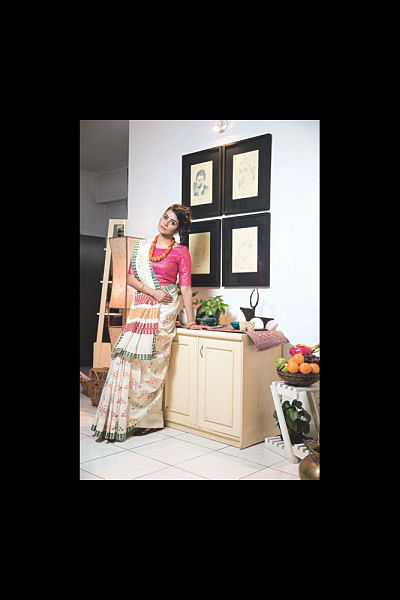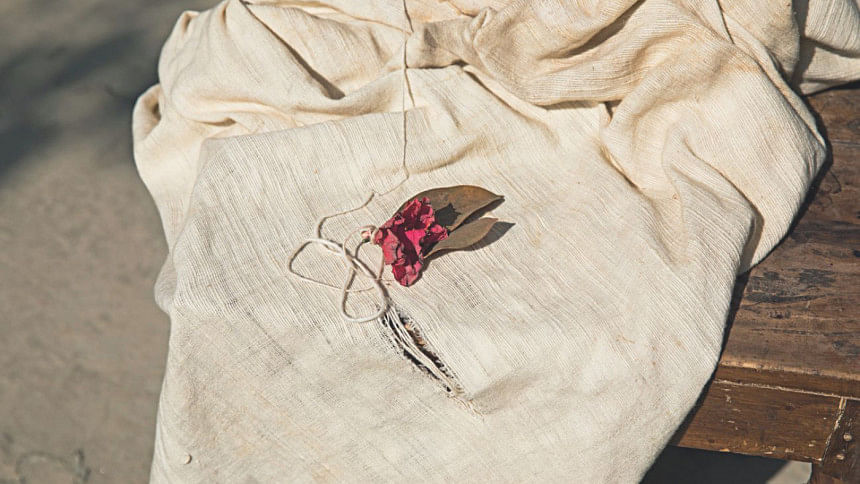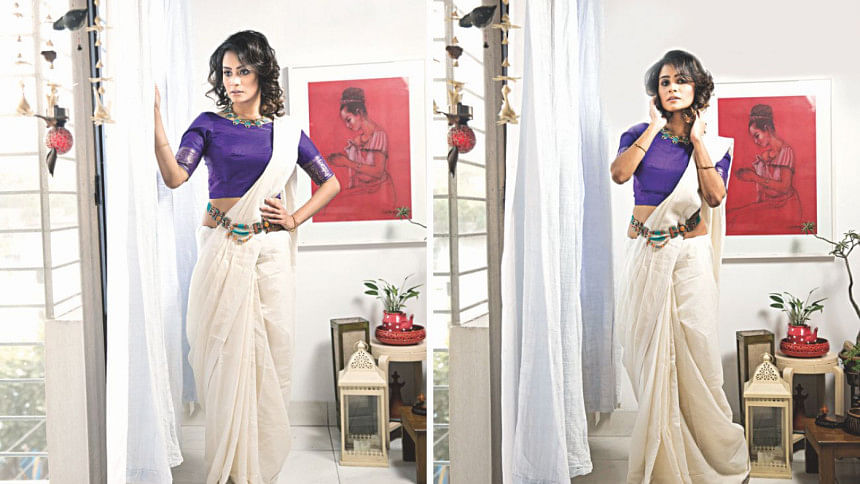Biased for a cause

“In this coarse thread given by Mother,
I see boundless
love foster,
We are stone fools, hence brother,
We beg at doors of
some other.”
-- Translation of the song
"Mayer Deoa Mota Kapor."
The cuckoo's call is ushering Spring, our favourite season. Once again, the premises of Charukola will fill with activities; cheerful women with garlands around their necks and gerbera blooms neatly tucked behind their ears will become a common sight.
Men too do not fall behind — they shall put on their Spring garbs, and some take it way further to getting a 'bhodrolok' look.
Truly, we do love Spring. The pleasantry of the season is just one reason; maybe it's just another excuse for us Bengalis to celebrate. We also rejoice at Pahela Falgun because it takes us back to a glorious past, now almost hijacked by boutiques and their fusion attires, telecoms with their new campaigns with fine prints that puzzle even the most seasoned cryptogram enthusiasts.
This was not the case even a few decades ago. Traditionally, Pahela Falgun was somewhat of a homely affair where friends would meet, sing songs and read poetry over a cup of steaming hot tea and some pithas, fresh from the bounty of Nobanno.
The norm to wear something traditional was still there, but no one would really think of buying something new for the occasion, and why would they? — every woman's closet back then had a good run of hand-loomed khadis made from hand-spun threads. Northern Bengal had its own signature taant saris, and women had plenty of Pabna beetis and other pieces, that we now term, heritage!
There was no need for anything new, because the previous generation already had the 'traditionals' covered!
Out parents slipped into the folds of the six-yard fabric every morning and moved with ease as they worked around the house, or out in offices. Most of our grandmothers never abandoned their saris, even as octogenarians.
Times change, as do sense of style and fashion 'ins.' It is taken for granted, and one finds no reason to stop such a moving culture. Unless, it takes us towards a perilous future.
The old ways have changed, and even the most ardent wearer of everything 'deshi' now feels the urge to buy something special for Falgun. This same emotion is felt in the textile, or apparel market during Pahela Baishakh, Sharodiyo Puja, and to some extent, even the Eids.
The fashion scene of the nation now centres around events and not seasons which has a negative impact on the production of fabrics, simply because the demand is brief, and the infra-structure to support this occasion-based demand is simply non-existent.
Very few actually buy taant, or khadi throughout the year, and even if they do, very few feel the urge to become patrons of heritage weavers. Some are not even aware of the difference between what is a famed Cumilla khadi, and what is its more affordable, power-loom version.
To the undiscerned eye, the non-textured fabric that feels softer on the skin, with plenty of scope to toy around by means of adding prints or embroidery, seems like a finer, more affordable and hence, a better option.

The history of khadi has been a long-standing one, and one that has a political, nationalistic connection, which we cannot deny. But that famed khadi is coarse; the finish seemingly incomplete, and the touch to the skin not half as comforting.
With the price equation in play, power-looms win hands down. That puts the very existence of producers of pure khadi in a dangerous situation. In fact, the threat is so real, that these weavers are now almost on the verge of extinction.
Not only did power-looms replace handlooms, the import of cheaper versions of taant from India has created more pressure on weavers of taant to lower prices, and thus, there is a visible decline in the quality of Bangladeshi products.
The demand of mass produced fabric has an undeniable greater appeal, for its affordability. But the more we lean towards factory products, the more weavers struggle. Thus, in a way, our one-day fancy of being Bengali is hampering the very thing we are trying to do — promoting heritage weaves.
People are quick to compare products of Bangladesh with neighbouring India, but fail to consider that the Indian domestic market is far larger than Bangladesh. And this might come as a surprise to many, but Indian handlooms and heritage weaves are going through a similar crisis.
We are content with the four figure kanjivarams, but know this, the real McCoy, if you can find one easily in the much loved stores of Calcutta New Market, would really make a dent in your wallet, just like a cotton Dhakai Jamdani.
Now, can everyone afford to buy a real piece of khadi sari, or a shawl or a panjabi?
Yes,it is possible.
Can this be said for taant? Perhaps not.The matter becomes clearer when we bring into discussion Jamdanis and Nakshi Kantha saris.
Then comes the real question, how many does a fashion conscious woman require as far as heritage pieces are concerned? Is it really important to have a closet full of half-silks, rather than having just one or two, bought at the same price?
The famed Dhaka Muslin was renowned for its finesse, quality and exquisite finish. No one wanted to make a fabric suited for royalty into a household commodity. And if we can point out, it was the effect of the European industrial revolution that sabotaged our once global textile industry that once catered to global demand.
One may misunderstand my proposition. The socialites might say 'commoners' should stay away from such aristocratic indulgences. Some things never change.
We cannot, and nor will we even attempt to justify such snooty behaviour, quite prevalent in our society.

But ask yourself this, how many Hermes bags, if any, does one need to prove themselves stylish? The same parable goes for elegant Jamdanis to the humble khadis — rather than opting for the countless mill-run variants, buy one and stand in grace.
And lastly, one thing must be said. Most Bangladeshi retailers, even the biggest names, have now been drawn towards inferior quality. For some sellers, it is a matter of survival; for others it is perhaps greed more than anything else.
While I may ignore the small-time retailer who cannot afford to promote the real at the cost of not cashing in on what is available, the bigger houses must acknowledge that they have a duty to promote what they say they promote.
It's quite understandable that every retailer must cater to its loyal clientele, but it is also an obligation to create a loyal clientele. It is simply not enough to pass off the more affordable Jamdani as 'half-silk' and the pricier ones as 'cotton.' It is a demand of the times, and the demand of all weavers who are still carrying the legacy, that these large business houses teach, yes, really teach people the difference. They should run campaigns that will not only promote their brand value, but also make the consumers understand that the extra money that they are paying is for a better cause, for the promotion of a local heritage, and patronise the countless artisans who are the producers of the wide range of products we see, but hardly ever get a fair share from the more high-end produces.
Every fashion conscious male or female will tell you this, “they want to stand apart.” One can still own a taant, actually the time is still ripe for one to pick four or five pieces easily. What one must do is compromise quantity over quality. Compromise on monetary benefits over patriotism and promotion of products of this land.
For once, we ask you to respond, not to your senses, but to your indulgences. Buy one piece, if you cannot afford more, but buy what is real, and what is ours. All our lives, we desperately try to stand apart; let us try and blend in for once, because unless we take such stances collectively, our taant, our khadi, will become relics displayed in museums.
By Mannan Mashhur Zarif
Photo: Sazzad Ibne Sayed
Model: Mashiat
Wardrobe and Jewellery: LS Desk
Make-up: Farzana Shakil’s Makeover Salon
Styling: Sonia Yeasmin Isha

 For all latest news, follow The Daily Star's Google News channel.
For all latest news, follow The Daily Star's Google News channel. 



Comments